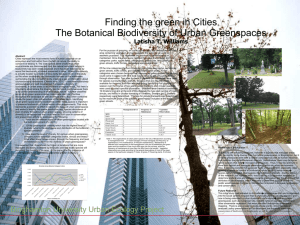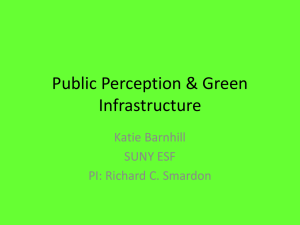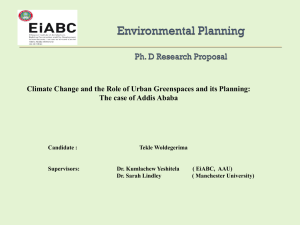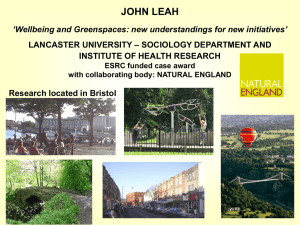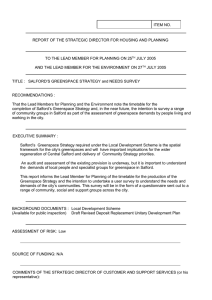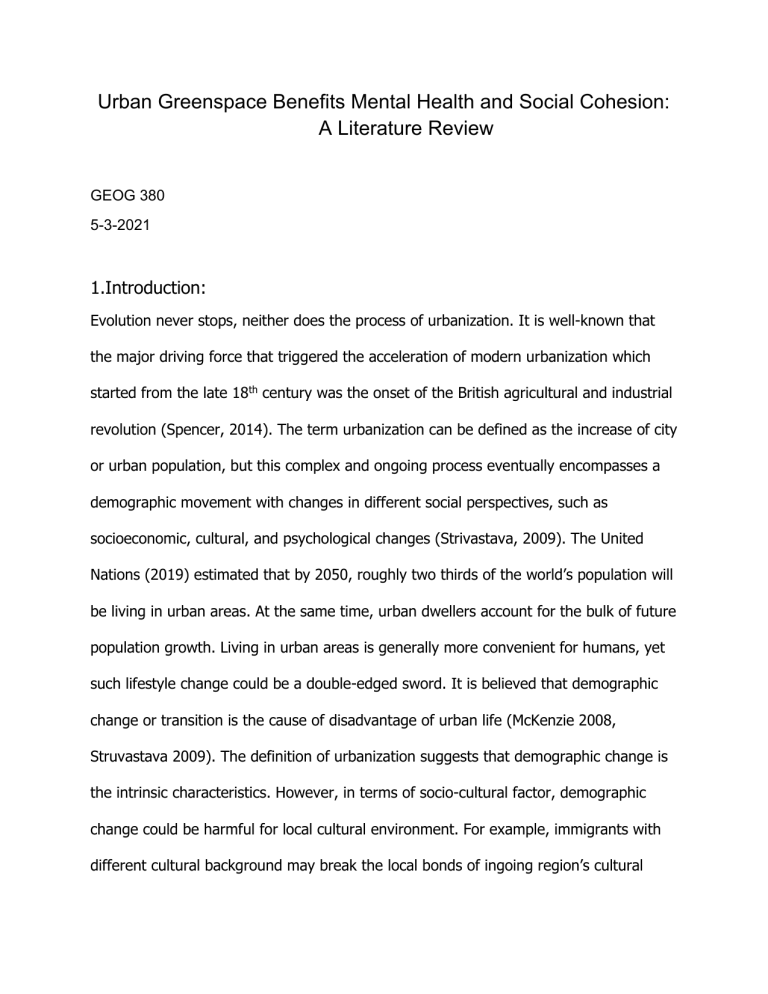
Urban Greenspace Benefits Mental Health and Social Cohesion: A Literature Review GEOG 380 5-3-2021 1.Introduction: Evolution never stops, neither does the process of urbanization. It is well-known that the major driving force that triggered the acceleration of modern urbanization which started from the late 18th century was the onset of the British agricultural and industrial revolution (Spencer, 2014). The term urbanization can be defined as the increase of city or urban population, but this complex and ongoing process eventually encompasses a demographic movement with changes in different social perspectives, such as socioeconomic, cultural, and psychological changes (Strivastava, 2009). The United Nations (2019) estimated that by 2050, roughly two thirds of the world’s population will be living in urban areas. At the same time, urban dwellers account for the bulk of future population growth. Living in urban areas is generally more convenient for humans, yet such lifestyle change could be a double-edged sword. It is believed that demographic change or transition is the cause of disadvantage of urban life (McKenzie 2008, Struvastava 2009). The definition of urbanization suggests that demographic change is the intrinsic characteristics. However, in terms of socio-cultural factor, demographic change could be harmful for local cultural environment. For example, immigrants with different cultural background may break the local bonds of ingoing region’s cultural tradition (McKenzie, 2008). On the other hand, concerning the socioeconomic aspect, relocation of immigrants requires the destination city infrastructures and facilities to be made available (Srivastava, 2009). Failing to meet such requirement would hinder the city from healthy development and eventually drag the deprived social group into the quagmire of, such as polluted environment, social isolation, reduced social support, city crimes and stressful life. Therefore, urbanization is a suitable yet risky answer for the contemporary needs, but humans need to act cautiously to maintain personal healthy life and well-being. Nowadays, a growing body of research with the considerable interest in stress control and enhanced social cohesion suggests the trend of finding positive associations between urban greenspaces and human well-being. In other words, people have already realized the importance of having natural elements penetrated their daily life. First of all, what kind of sparkle do you expect from combining the concept of urban greenspace and human mental health? In general, urban greenspace includes facilities that we are more familiar, such as public parks and roadside plants. In terms of human mental health, it is the component of psychological well-being such as emotional desires or sense of belonging. But why do we care about mental health, after all? According to the report from the World Health Organization (WHO), worldwide, deteriorating mental health cases are increasing as more and more people are suffering from symptoms like depression, mental disorders, schizophrenia, and suicide (WHO, 2020a). The causes for these symptoms are varied, but the factor that keeps showing up is inordinate stress. Yet, stress itself is not a disease; in fact, humans need it. Trace back to our ancestors who required a certain level of stress to ignite their will to live, it was indispensable for them to stress themselves out when facing threats like chasing by a predator. However, more and more people are now living in urban areas with a safer environment, humans have gradually lost their reason to fight or flight. Consequently, even though people in modern society still need certain amount of stress to handle with difficulties or dilemmas, feeling stressful is not as indispensable as human needs it in the past. Since more and more people are now living in urbanized areas, human has become social animal. At the same time, living in the “jungle of concrete”, human requires certain capitals to satisfy their needs. Capital can be defined as any substance that confers certain value to its owner, and social capital, as described by McKenzie and Harpham (2006), includes the criteria of civic participation, social networks and trust. That said, social capital is something indispensable for modern urban dwellers to retain. Losing social capital is adding risk of suffering from social isolation, the loss of sense of belonging, or the indifferent atmosphere in a community, etc. Studies (Jennings and Bamkole 2019, McKenzie 2008, Ward Thompson et al. 2016) have also found that people living in socio-economic deprived areas tended to have lower level of social capital and poorer mental health due to the above-mentioned negative factors and the failure of a neighborhood meeting the needs of demographic changes. However, is it possible to change the physical environment in order to enhance people’s mental health and social capital? Due to the intrinsic difficulty of figuring out causal association between human and nature, it is similarly difficult to uncover the behindthe-scenes mechanism that contribute urban greenspace’s benefits to human health. Yet, increasing researchers are trying to unveil the reason why people crave the greens or the nature, and what people have done to interact with the nature and what are the potential benefits of doing so. This literature review attempts to explore the different benefits that urban greenspace can potentially provide for humans by reviewing several academic articles. We therefore hypothesize that the present of suitable amount of well-managed urban green space may build up human’s well-being by improving mental health and social cohesion. 2. Nature and Human health Biophilia, as proposed by Roger Ulrich in 1993 and reviewed in later study (Grinde and Patil, 2009), is a term used to describe human’s inherent inclination to affiliate with nature. For example, from a financial standpoint, shouldn’t a mega city like New York to have the Central Park removed and replace it by more skyscrapers? On the contrary, people want more greens to be added to their urbanized environment. For another example, in terms of practical matter, think about why apartments with balcony ask for more, or why some people would like to plant plants in their room. Isn’t it sound like loving the greens or the nature is something penetrated in our genes? Roger Ulrich proposed the psycho-evolutionary theory in 1993, suggesting that humans potentially adapted to nature in their journey of evolution over a long period; consequently, without being culturalized, humans have the predisposition of craving the characteristics of nature, such as vegetation and waterbody (Ulrich, 1993). In other words, the yearning of nature is the product of humans’ evolution accompanied by the interaction with the natural environment. Nevertheless, how does such theory relate to human mental health? In 1986, Orians suggested that specific vegetation or landscape has a higher aesthetic attraction to our pre-modern ancestors (as cited in Orians, 1986). That is to say, humans in the past would find it relaxing when they came across a plenteous and peaceful environment since they do not need to worry about the supply of food and being chased by a lion for at least a period of time. Grinde and Patil (2009) used the concept of zoological gardens to analogize the discords showed by unhappy animals in zoo with unsuitable living condition to human residing in urban areas. It is believed that these once wild animals need certain facilities and consequently an appropriate living environment in the zoo to keep themselves from discords (Grind and Patil, 2009). That said, human once lived in wild environment, but now living in urban areas, would experience the similar discords from the mismatch of what the environment is provided and what their “inner voice” is asking for. Basing on their reviewed on other empirical studies, Grind and Patil (2009) also suggested that adding the element of nature or greens or merely an indoor small potted plant would have beneficial consequent to those who suffering from stress or mental condition. The above-mentioned studies are based on observation and literature review. Yet, van den Berg et al. (2002) had done sufficient job in a successful experiment and had found out the restorative potential of natural environments in mental health. In a nutshell, van den Berg et al. (2002) asked participants to firstly watch an abridged frightening movie in order to initially create a stressful mood or emotion, and then participants were provided with another video showing either a natural or a built environment. Following, participants were asked to rate the level of beauty shown in the environmental video and were tested with a concentration activity. The results showed that, first, the participants perceived the natural environments as more beautiful than the built urban, and second, the concentration test also showed higher score from those who had viewed the video with natural environment (van den Berg et al., 2002). To sum up briefly, urban greenspaces may benefit mental health by providing elements that resemble natural environment. 3. Social Cohesion and Human Health Mechanisms decoding the relationship between social cohesion and mental health can likewise help hypothesizing the use of urban greenspaces potentially improve personal well-being. Regarding the functional outcomes of urban greenspaces, Kim and Kaplan (2004) suggested that natural features provided in a community design might have enhanced sense of place belonging (or sense of community) via community identity, connection between people through social interaction, and the practice of pedestrianism. Similarly, in Jennings and Bamkole (2019) and McKenzie (2006) studies, they too proposed that features like feelings of trust, community network, civic engagement, etc., to be the main components of social capital. Particularly, Jennings and Bamkole (2019) proposed the term of “social cohesion” as it dominates the term social capital and furtherly defined it as the plausible product of owing and administrating the social capitals in a healthy way that could benefit both the individual and the community. It seems like the term of social capital and social cohesion can be interchangeably used in evaluating the connections between social affairs and mental health, yet for this literature review, these two concepts will be articulated. Nevertheless, how are social cohesion and mental health intertwined together? What are the possible mechanisms? Several 2000s studies focusing on finding evidence of how people engaged physically in social, or community events will be provided in the following section. 4. Evidence of How Urban Greenspaces Benefit Human’s Well-being 4.1 The Use of Survey Studies The majority of studies used in this literature review was conducted by survey or questionnaire. Again, it is difficult to record human’s psychological changes without using certain instruments to tract the physiological variables in laboratory. Consequently, many of the studies investigating human’s mental health impacted by urban greenspaces were making analyses to the self-report data collected from either mailed or online questionnaires. Yet, with the helps from previous contents which reviewed the achievements from solid experimental studies, we now have a clear picture of how these theorical concepts would explain certain feedbacks collected from the survey study. The following portion of this article will therefore review study and research done in different part of the world with different targeted social group, different time, various methodological criteria for analysis, and divergent discussion yet similar conclusions. 4.2 The Present of Urban Greenspaces, Physical activity, Mental health In their studies, Sugiyama et al. (2008) drew 2,194 eligible study samples from 32 neighborhoods in urban Adelaide, Australia. In a questionnaire, participants were asked to rate their physical and mental health; besides, to identify the perceived greenness of a neighborhood and to assess the social cohesion, participants were asked to rate the accessibility of the urban greenspaces like parks or nature reserve and respond to questions regarding social capitals. With the result suggesting positive and functional mediating role of recreational walking, this study added to the evidence that neighborhood urban greenspaces are more associated with mental health and physical health under the impact of physical activity. That said, “walkable” green environment accounts for the increased chance of physical activities that associate with social interaction and indicates its beneficial role for offering restorative effects (Sugiyama et al., 2008). de Vries et al. (2013) extended the work of Sugiyama et al. (2008) and hypothesized the positive relationship among quality of urban greenspaces, social cohesion, and time spent on physical activity. Similarly, de Vries et al. (2013) randomly selected residents for an analogous questionnaire survey; however, unlike what was done in Sugiyama et al. (2008) study, de Vries et al. decided to omit the portion of urban greenspaces assessment. Instead, this assessment was done by another group of trained observers to objectively evaluate the level of greenness among the targeted neighborhoods. Results showed that 1,641 responders live in neighborhood with higher quantity and quality of greenspaces have a better mental health, accompanying with similar results regarding social cohesion perspective (de Vries et al., 2013). Nevertheless, results showed relatively weak relationship between physical activity and mental health. de Vries et al. (2013) furtherly explained that the energy expenditure consumed by physical activity might not generate health benefits directly, instead, the greenish environments and/or the social cohesion that is facilitated might be the true healers. In other words, de Vries et al. (2013) concluded that the quality of the urban greenspaces and the process of engaging with the community and gaining social support are the major contributors to better mental health, deviating from the conclusion that walkable physical activity is the most important contributor from Sugiyama et al. (2008) 4.3 The Present of Urban Greenspaces, Social Cohesion, Mental health As discussed above, urban greenspaces help improving social cohesion, and consequently strengthen people’s sense of community or place belonging. Besides, from previous studies, Jennings and Bamkole (2019) and McKenzie (2006) and Kim and Kaplan (2004), indicate that the assurance of full charge of individual’s social capital is the safe net for one’s well-being. Speaking of personal sense of safety, it is necessary to make reference from Maslow’s Hierarchy. Maslow’s Hierarchy of Needs is a psychological idea proposed by Abraham Maslow in 1943 (McLeod, 2020). To represent human’s need in a hierarchical manner, Maslow suggested that people are motivated to achieve certain needs, and he ranked these needs in a pyramid with the more basic needs at the bottom, like the physiological needs. These physiological needs contain basic biological requirements for human survival, such as air, food, drinks, etc. A higher level is called the safety needs, and once an individual’s physiological needs are met, the needs for this level—safety needs become salient. In other words, insuring one’s social capital, such as improving one’s sense of belonging, can accordingly enhance his/her sense of safety. In a literature review, Kazmierczak and James (2007) proposed four potential mechanisms that account for how urban greenspaces benefit social cohesion: 1. Greenspaces are free and accessible to the public, 2. Greenspaces are social arenas, 3. Greenspaces ease stress and mental fatigue, and 4. Greenspaces provide chances for volunteer activities. In general, urban greenspaces offer location and opportunity for people to gather together in almost no cost. Such social gathering practice may help the members from a same community to know each other better. Think about international students or foreign immigrants going back to their hometown, it is easy to predict that they will regain the sense of belonging since they know who these local people are in their hometown, and they know what these local people are doing, and these local people will know who they are. Without being troubled with anomie, as a person loses the knowledge or feeling of what is happening in a place and consequently suffers from alienation, having sense of place belonging will fasten and anchor that person to a particular place-- a place he or she has a connection with. For our purpose, urban greenspaces will likewise provide physical or material condition to satisfy human’s needs of social engagement. 4.4 Assessing the Urban Greenspaces The present of urban greenspace can be a double-edged sword. It can be amenity as it provides benefits like easing stressful emotion and promoting social interaction, but it can also be troublesome. As increasing number of countries and cities are taking measures to increase urban greenspaces, Bertram and Rehdanz (2015) suggested in their study that wisely planning for suitable amount of urban greenspace is more important. Online survey targeting the study area of Berlin, Germany was given to 485 participants to record data regarding their usage and perception of urban greenspaces; in addition, participants were also asked to provided residential address if possible so that ArcGIS could be used to map out the spatial relations between physical urban greenspace and participants’ adjacency (Bertram and Rehdanz, 2015). Consequently, an inverted U-shaped relationship between urban greenspaces and well-being was found. That is to say, people enjoy seeing certain amount of greenspaces available as such method indeed increases their well-being. Yet, overdose of greenspace may crumble the amenity. Another U-shaped relationship between distance of urban greenspaces and well-being was also found. In other words, people would like to have greenspaces available for them within a certain distance of their residency (Bertram and Rehdanz, 2015). The study furtherly suggests an implicit MRS of Eur 26.82 per person per hectare per month (Bertram and Rehdanz, 2015). As MRS stands for “Marginal Rate of Substitution”, it means the rate at which a person can give up certain amount of one good in exchange for another good while enjoying the same level of utility. In this situation, the author suggests that people would like to pay 26.82 euro each month to continuously maintain their access to urban greens. This study also shows that the area of the green space that led to the largest positive effect on life satisfaction is 35 ha, yet ¾ of the respondents have less than this area of urban greenspaces available (Bertram and Rehdanz, 2015). Therefore, having a “just right” supply of urban greenspace is essential to maximize the benefit. 4.5 Urban Greenspaces in Deprived Areas Urbanization brings opportunity and prosperity, but it could also degrade into a hotbed for urban diseases. At the same time, residents from socioeconomic deprived areas tend to suffer more from mental condition, majorly due to the poorer physical environment, social isolation due to the absent of sense of safety, and less community stability (McKenzie, 2006). In the studies of Ward Thompson et al. (2016), researchers conducted a face-to-face survey with the focus on stress level, mental health and general health among around 400 participants from four of the most socioeconomic deprived areas (communities) in Scotland; besides, participants were also asked to share their level of physical activity and social well-being. The results showed that factors contributed to stress level, mental and general health are different among the four communities; nevertheless, several factors remained common in all studied areas. Ward Thompson et al. (2016) found that the present of urban greenspaces generally associates with lower stress level and better mental and general health for all communities; especially for the most deprived communities in the study, having a private garden or an allotment improves residents’ mental condition greatly. Allotment is the practice of renting a plot of land from the city so that people can plan vegetables and fruits on it as a community garden; such activity is popular in European countries. Next, for the most deprived community, the present of views of greenness helps the residents the greatest comparing to the other three communities (Ward Thompson et al., 2016). The authors furtherly explained that people from more deprived region tended to initially suffer more from social isolation, the loss of sense of belonging and social trust; consequently, they are in urge needs of “salvation” from urban greenspaces. This explanation was furtherly justified by another factor—level of physical activity, as the result also showed that physical activity contributes little to stress mitigation, yet social isolation and place belonging related to stress level tightly (Ward Thompson et al., 2016). The authors indicated that the process of having physical activities in urban greenspaces was the ultimate contributor to stress mitigation as people could interact with each other to enhance the sense of belonging and neighborhood trust; besides, there was no doubt for the positive relation between physical activity and general physiological health (Ward Thompson et al., 2016). Such conclusion is once again, deviating from the suggestion from Sugiyama et al. (2008). 4.6 Longitudinal Effect of Urban Greenspaces in Mental Health Many of the studies investigating the urban greenspaces and mental health used the method of cross-sectional survey, yet a longitudinal examination is necessary. Alcock et al. (2014) proposed three possible hypothetical patterns to predict how movers’ mental health would improve or decrease previous, during and after their move from greener (less green) places to less green (greener) places. First, the adaption hypothesis suggests that movers may experience improvement in mental health after moving to greener environment, following by a decrease as they adapt to the newer greener surroundings (Alcock, et al., 2014). Secondary, the sensitization hypothesis suggests that movers to greener environment may initially show few or even no improvement on their mental health, following by gradual improvement after they know where the local greens are and begin to use them (Alcock, et al., 2014). Finally, movers may experience better mental health after their move and maintain such consequent, thereafter, suggesting a shifting baseline hypothesis (Alcock, et al., 2014, pp. 1248). Samples were drawing from five consecutive annual survey waves of the British Household Panel Survey (BHPS) to identify movers within study areas of the U.K. A General Health Questionnaire (GHQ) was then given to the movers and data was recorded accordingly to assess participants’ mental health. Movers who moved to greener area from less green area have lower initial scores of mental health than those who moved from greener to less green (Alcock, et al., 2014, pp. 1253). Next, movers who moved to greener area from less green area would improve their mental health score gradually to the same level of the movers who moved to the less green area from the greener area. Movers who moved to greener areas experienced significant improvement in mental health after three years of relocation; however, the improvement in mental health stabilized quickly post move for the following three years (Alcock, et al., 2014). Thus, the data best support the shifting baseline hypothesis even though the first wave of improvement may fit the sensitization hypothesis. While movers who moved to less green areas showed a significant decrease in mental health, yet adaptation was observed for the three years post move (Alcock, et al., 2014). Generally, mental health is better in greener urban area, yet the work done by the urban greenspace could be time-limited, as the adaptation hypothesis suggests. At the same time, the work done by the greens might take time to reflect to mental health as implied by the sensitization hypothesis. In other words, mental health improved from urban greening might be maximized when developments are accompanied by information campaigns and healthy lifestyle promotion works. Consequently, movers who moved to the greener areas, the shifting baseline hypothesis best fit the data, because they are now having a better mental condition than before, yet the rate of improvement will slow down gradually and maintain a same level thereafter. For movers who moved to the less green areas, the adaptation hypothesis best fit the data as their mental health would decrease initially but receive no significant changes after three years of the relocation as movers will adapt to the physical environment in the new location (Alcock, et al., 2014). Therefore, effects on mental health generated by urban greenspaces may be short-lived; yet mental health is better in greener areas without doubts. 5. Urban Greenspaces, COVID-19, Mental Health 5.1 An Unusual Time So far, both the theorical mechanisms and evidence from studies regarding urban greenspaces and human’s well-being have been discussed. Put together, urban greenspace plays its critical part on benefiting mental health and social cohesion by providing physical and natural environment that cater human’s mental demands and offering opportunities for social interaction among various social groups. However, due to the outbreak and its rapid spread over the whole world of COVID-19, governments around the world have been requiring their people to practice social distancing and restrict unnecessary outdoor activities. One of the major pathways of how urban greenspaces benefit well-being, as suggested in (Sugiyama et al., 2008) and (Kazmierczak and James 2007), is the physical visit of greenspace accompanying with the process of social engagement. Due to the practice of social distancing, for example, it is unwise for people to gather together in a park or other outdoor greenspaces for certain social events. Consequently, the lost of regularly contract with urban greenspace due to the pandemic might interrupt the wellness brought by social cohesion. At the same time, WHO also released the study regarding the impact of COVID-19 on mental, neurological and substance use services (MNS) (WHO, 2020b) and found that people around the world generally suffered from symptoms like delirium, agitation, insomnia and depression associated with the pandemic, and the demand for MNS services increased sharply. Researchers around the world are likewise working hardly to study this new relation between urban greenspaces and restricted accessibility; accordingly, newer finding and evidence of urban greenspace are rising in response to the proper time and conditions. 5.2 Urban Greenspaces benefit Mental Health through “Less Immediate” Experience Do people have to physically visit the urban greenspaces to nourish their mind and body? During the pandemic, when people are becoming less likely to physically visit any public greenspaces, greens around their residence may become more important; as a result, Soga et al. (2020) conducted an online questionnaire research to testify this opinion. This online survey aimed at assessing participants’ mental health condition, frequency of urban greenspace visiting by physical pathway and availability of viewing greens from their residence, and their sociodemographic information; in addition, participants were asked to provide postcode if applicable so that the level of greenness around the residences could be analyzed (Soga et al., 2020). The study results suggested that both greenspaces use and green view were significantly positively associated with mental health and personal well-being; while the factor of neighborhood greenness that assessing the availability of greenspaces within 250 meter buffer of residence contributed few to mental health. What’s more, better mental health and well-being were found associating with frequency of greenspace use around the residence and green views availability (Soga et al., 2020). But one particular finding from this study was that the use of green view is more efficient than greenspace use. Soga et al. (2020) furtherly explained that because of the practice of social distancing, people would tend to stay at their home. In other words, less immediate nature experience like seeing greens through window has comparable effect as more immediate experience like physically visiting the park. During the pandemic, when a large amount of people was isolating themselves in home, having views of the natural landscapes benefited their mental health and eased their tensive emotion. Thus, urban greening policies must go well beyond merely increasing the number of public greenness, and they should make better arrangement of these green components and maximize people’s personalized levels of nature (Soga, et al., 2020). 5.3 Urban Greenspaces Uses as Resilient Infrastructure under the Pandemic From the previous discussed studies, the majority of methodological pathway in analysis focused on the use of self-report subjective feedbacks regarding mental or physical health. In Venter et al. (2020)’s study, the subtle method of tracking Oslo, Norway, citizens’ spatio-temporal mobility through the user data from STRAVA, an internet service for tracking human exercise, was used to investigate people’s behavior changes for recreational activity during the pandemic (Venter et al., 2020). Research found that outdoor recreational activity by walking or cycling increased by 291% during the 2020 lockdown comparing to the previous three years in a row; in terms of spatial pattern, these changes were intensified in the urban periphery, adjacent to urban greenspaces with lower population density (Venter et al., 2020). Two detailed findings from the analysis include: 1. Daily cycling temporal rhythm changed from concentrated on morning rush hours to evenly distributed in daytime, 2. Spatially, cyclists preferred trails with less green, while pedestrians preferred trails with higher tree canopy cover (Venter et al., 2020). The authors decoded these phenomena as that: 1. Major cyclists previous to the pandemic could be those who commutes to work daily during the rush hours but increasing number of new cyclists were added to the city for recreational purpose during daytime; 2. Cyclists tended to focus on riding instead of enjoying the greenish nature while pedestrians were not restricted by this reason, so these two groups had different preferences (Venter et al., 2020). What’s more, the authors also suggested that people tended to choose urban greenspaces relatively far from the densely populated city center for their recreational purposes was the evidence of following the practice of social distancing; at the same time, the authors hence implied that accessible yet unattended greenspaces in the urban periphery could have added additional resilience to the city’s public health during the pandemic (Venter et al., 2020). Even though this study did not conduct further investigations, for example, giving out survey to the STRAVA used for a self-report data collection and analysis just like most of the above-discussed studies did, people’s urge and craving for the greens are self-evident. 6. Conclusion Shakespeare describe those who charges with great achievement and responsibility bear a heavy burden as “Uneasy lies the head that wears a crown.” Since humans have chosen to follow the way of urbanization, they must therefore learn to embrace both the cheerful convenience brought by the process and the side effect of social degradation. When the God was creating the world, he assigned the most rigid concept for human—time. Every single person on Earth shares the same length of the day; however, the modern urban lifestyle seems to be trying to steal minutes and hours from us—multitasking and its consequence--stress. Yet, such urban lifestyle should not be the only sinner to be blamed for, humans themselves are the “accomplice”. There is no shortage of examples from our daily life regarding humans’ love and yearning for various forms of nature to be available in their living environment. Nevertheless, the esoteric mechanisms of how urban greenspace impacts humans’ well-being in terms of mental health and social cohesion were not appreciated generally and consciously. To make remedy in some degree, this literature review was trying to articulate the “characters” and scenarios that participated in the journey of searching for redemption of reuniting human and nature. Generally, reviewed studies regarding urban greens and human mental health were done by conducting cross-sectional research like finding associations by analyzing data collected from questionnaires. There is no lack of experimental means like the study done by van den Berg et al. (2002), and the longitudinal analysis done by Alcock et al, (2014), and the resident mobility analysis done by Venter et al. (2020). In addition, interestingly, study results may suggest conclusions that are not acknowledged by people as common sense. For example, as discussed above, physical activity or exercise done in urban greenspace may not account for the improvement on mental health as suggested by Sugiyama et al. (2008); instead, the process of engaging with local community might be the point taker. In a nutshell, through the above studies, it is obvious that the presence of urban greenspaces benefits people’s mental health and well-being by easing their stress or improving social cohesion and belonging. Stress, once again, is not a disease. Modern people can even benefit from a moderate level of stress and consequently increase their working efficiency. However, there is no reason to choose to be stressful. However, whenever the situation becomes unmanageable and suffering from stress becomes inevitable, it is important to remember that, deep in our mind as a mechanism which has casted in our genes for generations, taking a breath by embracing the nature is helpful. Especially during the pandemic, when the pathway of improving mental health through social connection is prohibited, a less “immediate” method of enjoying greens from windows can likewise benefit mental health. Last but not least, to prevent being devoured completely by the enormous waves of this epoch, this so-called Anthropocene, and to prevent being enslaved by the guilty cage in this so-called “screen age”, and to prevent being overthrew someday by the invasive and seemed-unstoppable advance of urbanization and its encroachment of the nature, and finally, to prevent the most beautiful flower on the earth—human’s mind from being destroyed, it is necessary for humans to take steps to defend the oases in the “forest of concrete”. Work Cited: Alcock, I., White M.P., Wheeler, B.W., Fleming, L.E., and Depledge, M.H. (2014). Longitudinal Effects on Mental Health of Moving to Greener and Less Green Urban Areas. Environmental Science & Technology, 48 (2), 1247-1255. Bertram, C., & Rehdanz, K. (2015). The role of urban green space for human wellbeing. Ecological Economics, Vol, 120. pp. 139-152. https://doi.org/10.1016/j.ecolecon.2015.10.013 Grinde, B., & Patil, G. G. (2009). Biophilia: does visual contact with nature impact on health and well-being? International journal of environmental research and public health, 6(9), 2332–2343. https://doi.org/10.3390/ijerph6092332 Jennings, V., & Bamkole, O. (2019). The Relationship between Social Cohesion and Urban Green Space: An Avenue for Health Promotion. International Journal of Environmental Research and Public Health, 16(3). https://doi.org/10.3390/ijerph16030452 Kim, J., Kaplan, R. (2004). PHYSICAL AND PSYCHOLOGICAL FACTORS IN SENSE OF COMMUNITY: New Urbanist Kentlands and Nearby Orchard Village. ENVIRONMENT AND BEHAVIOR, Vol. 36 No. 3, May 2004 313-340 DOI: 10.1177/0013916503260236 Mckenzie, K. (2008). Urbanization, Social Capital and Mental Health. Global Social Policy, 8(3), 359–377. https://doi.org/10.1177/1468018108095633 McKenzie, K., & Harpham, T. (Eds.). (2006). Social capital and mental health. Jessica Kingsley Publishers. McLeod, S. A. (2020, March 20). Maslow's hierarchy of needs. Simply Psychology. https://www.simplypsychology.org/maslow.html Nutsford D., Pearson A.L., Kingham S., (2013). An ecological study investigating the association between access to urban green space and mental health, Public Health, Volume 127, Issue 11, Pages 1005-1011, https://doi.org/10.1016/j.puhe.2013.08.016. Orians, G. H. (1986). An ecological and evolutionary approach to landscape aesthetics. In E. C. Penning-Rowsell & D. Lowenthal Eds., Meanings and Values in Landscape. London: Allen & Unwin, pp 3-25. Soga, M., Evans, M. J., Tsuchiya, K., & Fukano, Y. (n.d.). A room with a green view: the importance of nearby nature for mental health during the COVID-19 pandemic. ECOLOGICAL APPLICATIONS. https://doi.org/10.1002/eap.2248 Spencer, J. H. (2014). Globalization and urbanization : The global urban ecosystem. Rowman & Littlefield Publishers Srivastava K. (2009). Urbanization and mental health. Industrial psychiatry journal, 18(2), 75–76. https://doi.org/10.4103/0972-6748.64028 Sugiyama T, Leslie E, Giles-Corti B, et al. (2008). Associations of neighborhood greenness with physical and mental health: do walking, social coherence and local social interaction explain the relationships? Journal of Epidemiology & Community Health. 62(5):e9. http:// 10.1136/jech.2007.064287 Ulrich, R. S. (1993). Biophilia, biophobia, and natural landscapes. The biophilia hypothesis, 7, 73-137. United Nations, Department of Economic and Social Affairs, Population Division. (2019) World Urbanization Prospects: The 2018 Revision. New York: United Nations. van den Berg, A. E., Koole, S. L., & van der Wulp, N. Y. (2003). Environmental preference and restoration: (How) are they related? Journal of Environmental Psychology, 23, 135-146. https://doi.org/10.1016/S0272-4944(02)00111-1 Venter Z. S., Barton D. N., Gundersen V., Figari H., Nowell M. (2020). Urban nature in a time of crisis: recreational use of green space increases during the COVID-19 outbreak in Oslo, Norway. Environmental Research Letters, Vol. 15, Number 10. https://doi.org/10.1088/1748-9326/abb396 Ward Thompson, C., Aspinall, P., Roe, J., Robertson, L., & Miller, D. (2016). Mitigating Stress and Supporting Health in Deprived Urban Communities: The Importance of Green Space and the Social Environment. International Journal of Environmental Research and Public Health, 13(4), 440. https://doi.org/10.3390/ijerph13040440 World Health Organiztion. (2020a). Mental Health. Geneva. World Health Organization. (2020b). The impact of COVID-19 on mental, neurological and substance use services: results of a rapid assessment. Geneva.
